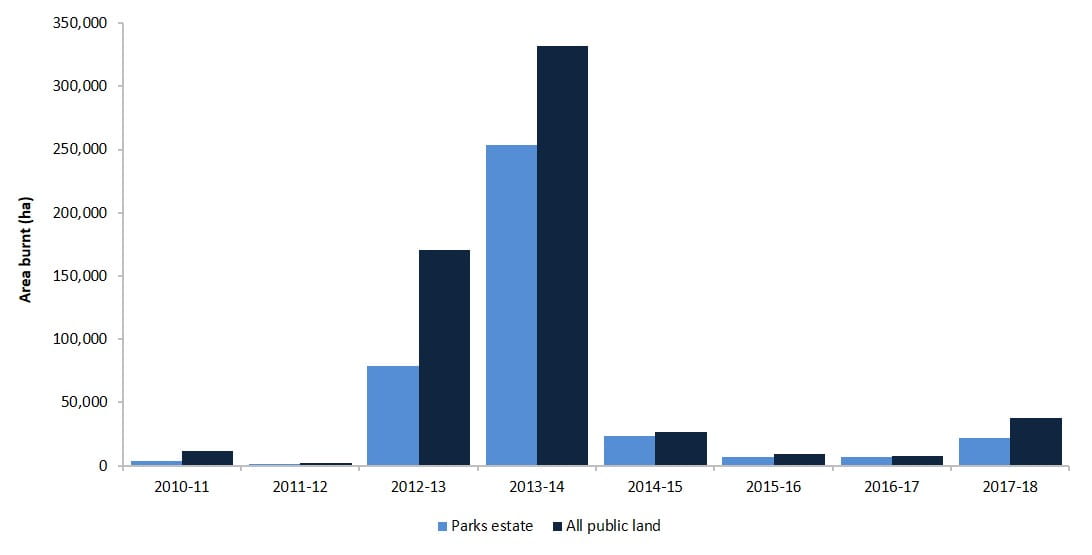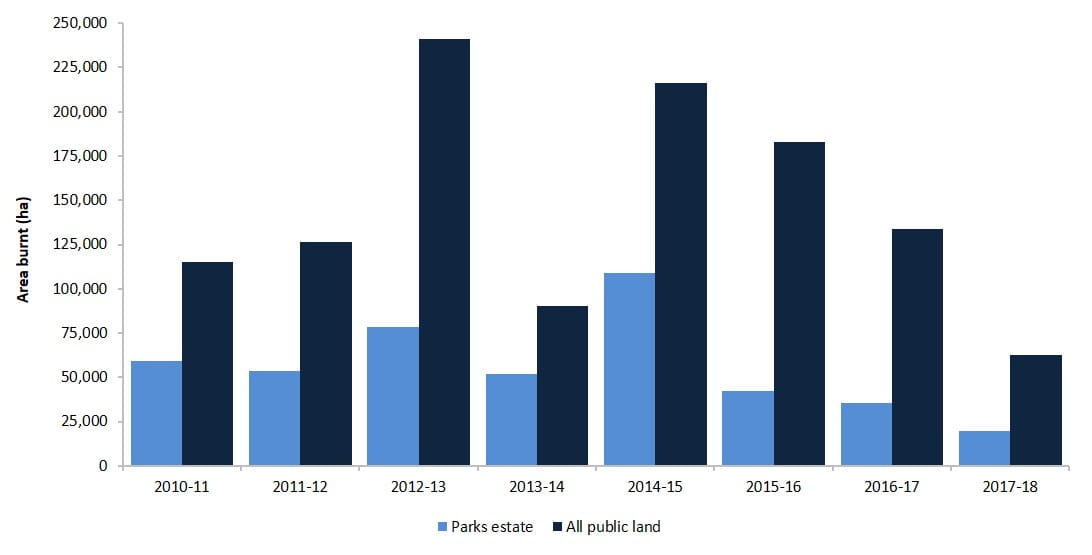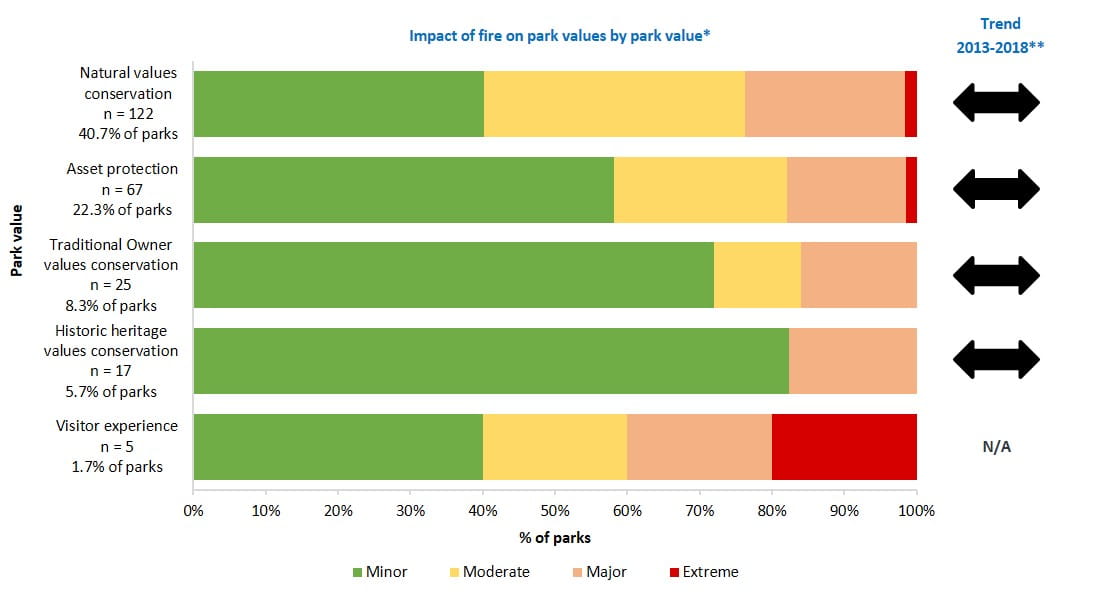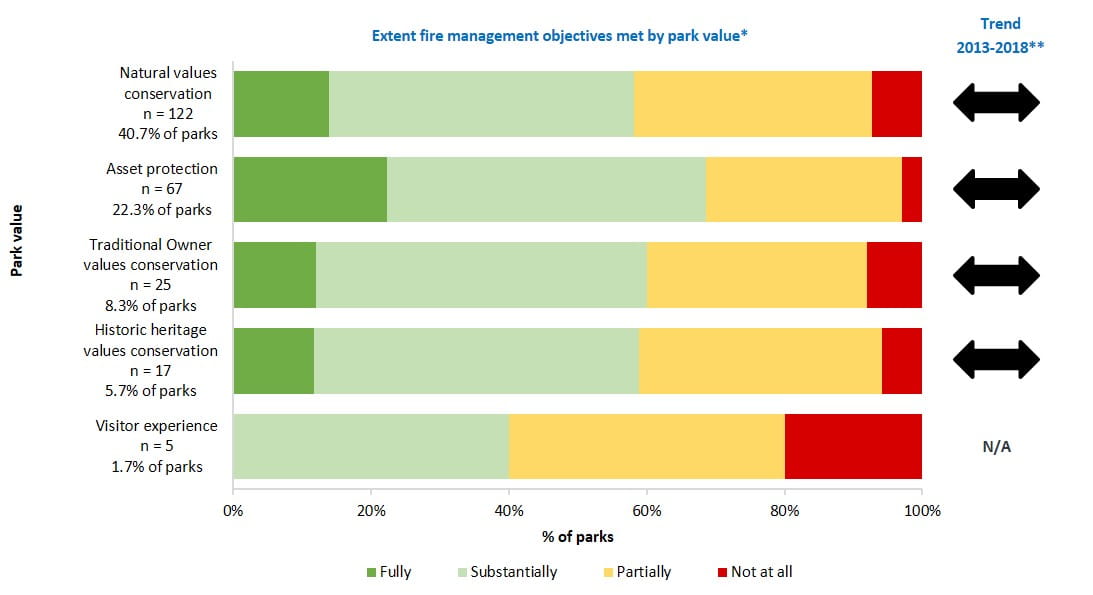Fire and emergency planning, prevention, response and recovery
State of the Parks Fourth Edition
Parks Victoria has a crucial role to play in fire and emergency management as a support agency and partner in the whole-of-government planning and response program. Parks Victoria supports the Department of Energy, Environment and Climate Action (DEECA) to prepare for, respond to and recover from bushfires on public land. Parks Victoria also has a key support role in other emergency events.
Parks Victoria works in partnership with DEECA responding to bushfires and conducting planned burns and other fuel management activities under the brand “Forest Fire Management Victoria” (FFMVic). In 2018, Parks Victoria signed a new Memorandum of Understanding (MoU) with DEECA, outlining their respective roles and responsibilities during fire and emergency situations (including blue-green algae outbreaks and dam failure). Parks Victoria also engages in a comprehensive monitoring and research program informing bushfire management planning. This includes pre- and post-fuel hazard monitoring, projects relating to ecosystem reliance, evidence-based management and application of ecological fire and post-fire regeneration in fire sensitive bioregions.
Indicators
Fire and emergency planning
Area burned by bushfire
Area treated by planned burns and other fuel treatments
Impact by fire on park values
Parks Victoria’s contribution to fire and emergency management
Effectiveness of fire and emergency management programs
Data confidence
Fire and emergency management
Fire and emergency management response
- Fire and emergency management is the most comprehensive and well-planned program of all park management programs. Park managers reported that 97% of assessed parks have a planned approach to emergency management while over 94% of relevant parks have a planned approach to fire management.

Data source: Parks Victoria State of the Parks assessments
Area burned by bushfire
- The annual area of the parks estate burnt by bushfire has varied widely between 2010 and 2018.
- In 2013-14, Victoria experienced its most significant fire season since 2008-09. More than 250,000 hectares of the parks estate was burnt (mainly in the Mallee and East Gippsland). Large area of the Grampians National Park also burnt.
- Significantly less area has been burned by bushfire since 2013-14.
Area (ha) burnt by bushfire across parks estate and all public land

Data source: DEECA
Area treated by planned burns and other fuel treatments
- Planned burns involve lighting fires under carefully managed conditions. By reducing fuel loads, planned burns help to lessen the impact of damaging bushfires on communities, property and the natural environment.
- The area of the parks network treated by planned burning to reduce fire risk and/or improve ecological values varied year-to-year (between a low of 19,676 hectares in 2017-18 to 108,860 hectares in 2014-15). This variance was largely based on the suitability of weather conditions for delivering planned burning.
- Planned burns are complemented by other activities to reduce fuel, such as mowing, slashing and clearing, to make and maintain fuel breaks.
Area (ha) treated for fuel management by planned burns

Data source: DEECA
Impact of fire on park values
- Park managers reported that the impact of fire on park values was minor or moderate in most of the relevant parks.
- Fire had a major or extreme impact on natural values in 24% of relevant parks.
- More than 70% of parks that identified either Traditional Owner cultural values or historic heritage values as being impacted by fire reported that fire impacts were minor; while 58% reported that fire impacts on asset protection was minor (54% by park area).
- The impact of fire on park values has remained stable since 2010.

*This assessment was optional for non-National Parks Act parks. **Calculated from parks that were assessed in both 2013 and 2018 (Natural values, n = 114; Asset protection, n = 56; Traditional Owner values, n = 19; Historic heritage values, n = 13)
Data source: Parks Victoria State of the Parks assessments
Parks Victoria’s contribution to fire and emergency management
Parks Victoria works alongside DEECA, the Country Fire Authority (CFA) and Emergency Management Victoria (EMV) to reduce bushfire risk and deliver the Safer Together program. This includes multi-agency bushfire awareness activities, multi-agency exercises (EMV, DEECA, CFA, State Emergency Service and Metropolitan Fire Brigade) focused on response capabilities and training, bushfire-centred Junior Ranger programs and releasing media around bushfire risk reduction.
Following the 2009 bushfires, the Melbourne Fire and Emergency Program was initiated that aims to directly protect communities that adjoin urban parks. During the 2017-2018 program, Parks Victoria upgraded 8.4 km of fuel breaks, slashed 798 km of fuel breaks, and upgraded 21 km of fire vehicle access roads.
In 2017-18 Parks Victoria employed 850 accredited ongoing staff to emergencies and 190 Project Seasonal Firefighters who are trained and available and responded to 1562 bushfires.
Emergency Recovery
Several large bushfires impacted on various parks and reserves across the State between 2013 and 2015 resulting in significant bushfire recovery programs. As well as impacting park infrastructure and services, the Aberfeldy-Donnelly’s bushfire in East Gippsland, Wyperfeld National Park-Bronzewing F.F.R bushfire in the Mallee, Chiltern-Mt Pilot National Park bushfire in North East, and Wye River-Great Otway National Park bushfire in the southwest had significant impacts on surrounding communities. The Grampians was impacted over two years in 2013 and 2014 with consecutive recovery programs following the Victoria Valley bushfire in 2013 and the Northern Grampians fire in 2014. Between 2013-2015 approximately $11.5M of bushfire recovery programs were delivered whilst finalisation of the $66M 2010-2012 flood and storm recovery was simultaneously occurring.
In 2016-2017 ten consecutive flood and storm events across the state caused widespread damage to parks, impacting thousands of assets, threatening cultural heritage sites and the environment, resulting in an $11.2 million recovery program, which is currently in its final stages of delivery.
Successful initiative funding (Treasury Advance/ERC) applications for the Northern Grampians complex bushfires and 2016-2017 Floods and storms have allowed programs to support the recovery of significantly impacted cultural or environmental values. Unless additional funding had been provided, the focus for most events has been on community recovery and replacement/repair of insured assets.
Effectiveness of fire and emergency management programs
- Of the 67 parks that identified asset protection as an objective of fire management, 68 per cent were fully or substantially meeting fire management objectives.
- Of the parks that identified historic heritage, Traditional Owner and natural values objectives, between 58 per cent and 60 per cent of fire management objectives were fully or substantially met.

*This assessment was optional for non-national parks act parks. **Calculated from parks that were assessed in both 2013 and 2018 (Natural values, n = 114; Asset protection, n = 56; Traditional Owner values, n = 19; Historic heritage values, n = 13)
Data source: Parks Victoria State of the Parks assessments
Data confidence
Confidence in park manager assessments for fire management

Confidence in park manager assessments for emergency management

Go to previous section of State of the Parks Fourth Edition: Fire and emergency management
Go to next section of State of the Parks Fourth Edition: Park planning and knowledge

